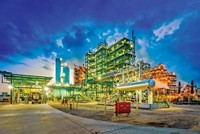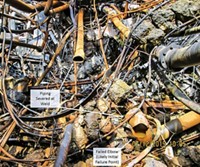Advertisement
Grab your lab coat. Let's get started
Welcome!
Welcome!
Create an account below to get 6 C&EN articles per month, receive newsletters and more - all free.
It seems this is your first time logging in online. Please enter the following information to continue.
As an ACS member you automatically get access to this site. All we need is few more details to create your reading experience.
Not you? Sign in with a different account.
Not you? Sign in with a different account.
ERROR 1
ERROR 1
ERROR 2
ERROR 2
ERROR 2
ERROR 2
ERROR 2
Password and Confirm password must match.
If you have an ACS member number, please enter it here so we can link this account to your membership. (optional)
ERROR 2
ACS values your privacy. By submitting your information, you are gaining access to C&EN and subscribing to our weekly newsletter. We use the information you provide to make your reading experience better, and we will never sell your data to third party members.
Safety
Fire And Ice
Abandoned, cracked pipe led to $50 million Valero refinery fire
by Jeff Johnson
July 14, 2008
| A version of this story appeared in
Volume 86, Issue 28

A LEAK FROM a high-pressure propane pipe, a four-day freeze, and the lack of remotely operated shut-off controls led to a Feb. 16, 2007, fire that caused serious burns to three workers at the Valero McKee Refinery in Sunray, Texas. That's the conclusion of a report released last week by the Chemical Safety & Hazard Investigation Board (CSB).
According to CSB, the accident occurred in the refinery's de-asphalting unit, where high-pressure propane is used to separate asphalt from gas oil, a feedstock for downstream processes.
A valve on a capped "dead leg" pipe that had been accidentally left partially open allowed small amounts of propane and water, entrained in the propane, to enter the pipe, the report continues. Water, which is denser than propane, accumulated in the low part of the unused pipe; when a stretch of unusual below-freezing temperatures occurred, the water expanded, cracking the pipe.
When temperatures returned to normal, a jet stream of high-pressure propane blasted from the crack. The leaking propane soon ignited, resulting in a cascade of fires and explosions that lasted for two days. The accident also released 5,300 lb of chlorine, used as a biocide for coolant water at the Valero refinery. The toxic release would have been a deadly threat to responders had they been able to enter the plant, CSB states.
The refinery was shut down for two months and ran with limited output for a year after the accident.
The CSB report concludes that the refinery lacked an effective program to identify and freeze-protect infrequently used piping and equipment and that its staff did not apply company policies requiring emergency shut-off valves. The industry and Valero, the report states, do not require adequate fireproofing of steel structures, which collapsed with the fire. Also CSB urges substitution of bleach for chlorine in coolant water.
Since the accident, Valero has created a process safety management department for its 16 refineries, redesigned its propane unit to include remotely operated shut-off valves, and substituted safer bleach for chlorine, which it now uses at only three refineries, company spokesman Bill Day says.
A safety video about the accident is available at www.csb.gov.





Join the conversation
Contact the reporter
Submit a Letter to the Editor for publication
Engage with us on Twitter